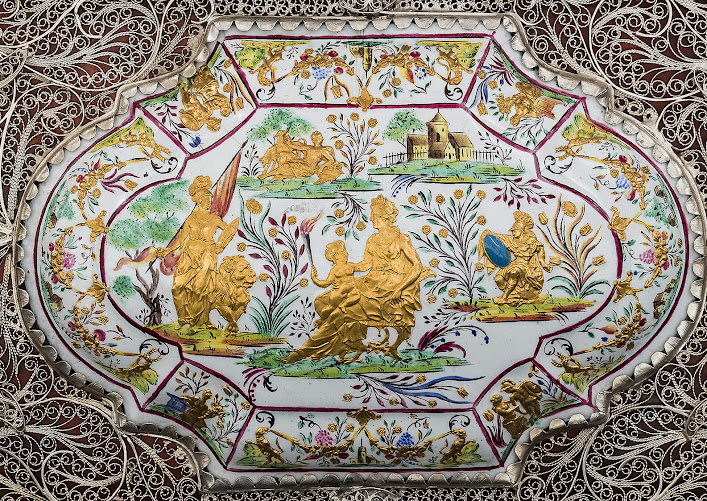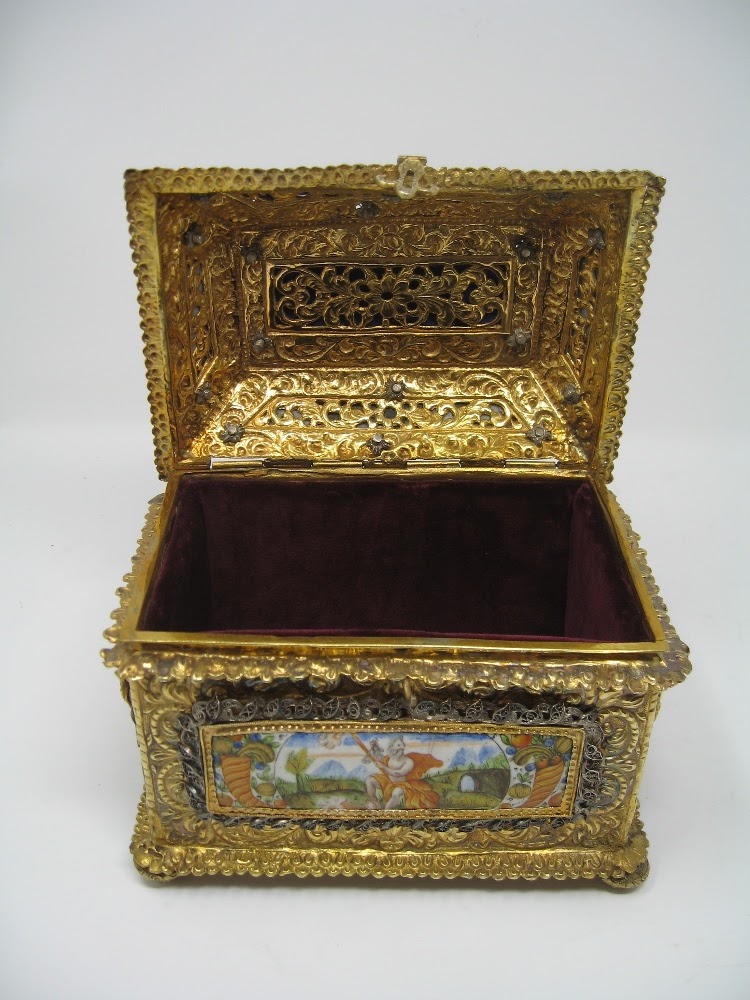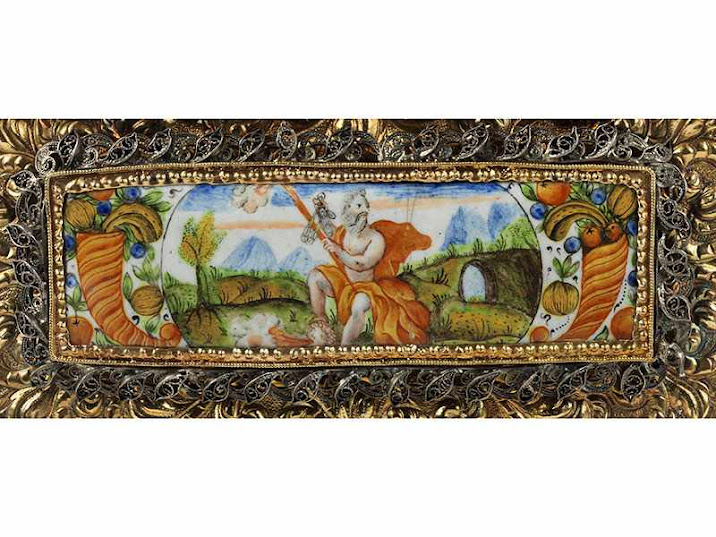Spectacular 18th Century Silver Filigree Casket.
with Enamel Panels attributed to the Workshop of Pierre Fromery of Berlin.
The filigree is perhaps South German or possibly Scandinavian.
Circa 1720 /1730.
(Post in preparation).
Length: 25 cm Width: 17.5 cm Height: 18.5 cm.
Private Collection.
Every so often I make an enquiry and receive back information which far exceeds expectations - this is the response to one of those enquiries.
.............................
Pierre Fromery (born Sedan, 1655 - 1738), Berlin. Left France in 1685, French Huguenot emigré.
Succeeded by his son Alexander (1695 - 1775).
The coffer’s enamel plaques relate to those adorning a toilet service in Rosenborg Castle. The silver work of this service was executed by Marcus Pipgros in Copenhagen in 1729 and the plaques were made in Berlin, suggesting connections between Berlin and Copenhagen craftsmen in the early/mid 18th century.
.............................
The construction of this casket is unusual - each panel appears to have been made separately and is held in place by numerous small tabs. The feet are also unusual
Back Panel
The Lid.
_______________________
Side Panel 1
_________________
Side Panel 2.
______________
The gold "Paillon" figures were inspired by medals made by Raymund Faltz (1658-1703) and Jean
Boskam.
Medal by Raymund Faltz, 1694, Münzkabinett Museen zu Berlin
....................................
Medal by Raymund Faltz, 1694, Münzkabinett Museen zu Berlin.
Medal by Raymund Faltz, 1693, Münzkabinett Museen zu Berlin.
................................
I cannot claim any responsibility for finding these images above, which were kindly provided by my anonymous informant.
.....................................
Paris 'paillons' made in 1720s and 1730s.
Paillons a technique which had evolved at St Cloud in the late 17th Century
Description of the Paillon technique below from the V and A website (link below).
The application of die-stamped gold foil reliefs (paillons) to enamelled boxes probably developed in response to fine chasing on gold mounts, piqué work in gold and silver often over tortoiseshell, carved coloured hardstone boxes and raised gilded moulded decoration on porcelain. After the metal die itself was designed and cut, the stamping from it of foil reliefs required far less skill and time than chasing and thus was a cheaper process. Until 1777, 'paillonneurs' operated as a separate guild within the Paris goldsmith trades.
One or more members of this guild are now thought to have
been responsible for providing die-stamped foils, some partially infilled
later by enamellers with translucent coloured enamels, for porcelain and
enamels decorated in 1720s and 1730s. This decoration cannot be attributed to a
single porcelain factory owing to the disparate origin of the pieces - China,
Japan, Meissen (Germany) and Saint-Cloud (France). They are thus
outside-decorated for sale as novel luxury-wares.
I am very grateful to the supplier of these images who wishes to remain anonymous.
Photography Guillaume Benoit.
____________________
The V and A Fromery Enamel Casket/ Snuff Box.
For this box and an excellent overview of the Fromery workshop
and his employee Christian Friederich Herold (1700 - 79) see -
https://collections.vam.ac.uk/item/O307018/snuff-box-pierre-fromery/
________________
Another Silver Filigree and Enamel Casket.
Victoria & Albert Museum.
Early/ Mid? 17th Century Filigree and Enamel Casket.
South German?
Perhaps Schwabisch Gmund.
Height: 11.00 cm, Length: 14.30 cm, Width: 9.00 cm
Museum number:M.109-1923
______________
Parcel Gilt, Silver Filigree and Enamel Casket.
17th Century.
South German? Nuremburg, Augsburg, Schwabisch Gmund.
Hempel, Auctioneers - 28 March 2019.
14.5 x 18.5 x 13.5 cms.
_____________
The Skinners Auctioneers Casket.
Currently no further data.
The Enamel panels are certainly South German, Perhaps Schwabisch Gmund.
________________
The North Brabant Museum Silver Filigree and Enamel Casket.
The bun feet suggest early 18th Century.
I suggest South German possibly Schwabisch Gmund.
This casket would be much improved with a gentle polish.
10 x 5.5 x 7.3 cms.
The enamel panels illustrating - Joseph sold into Egypt; the sacrifice of Abraham; marriage of Abraham and Sarah and two other unknown scenes.
__________
Silver Filigree Casket with inset Enamel Panels
18th century.
Perhaps South German Schwabisch Gmund.
Sold Cambi 2015.
15 x 11 x 7cms.
Sold Cambi 18 November 2015, Lot 244
___________________
.jpg)
.jpg)
.jpg)
.jpg)
.jpg)
.jpg)






























No comments:
Post a Comment